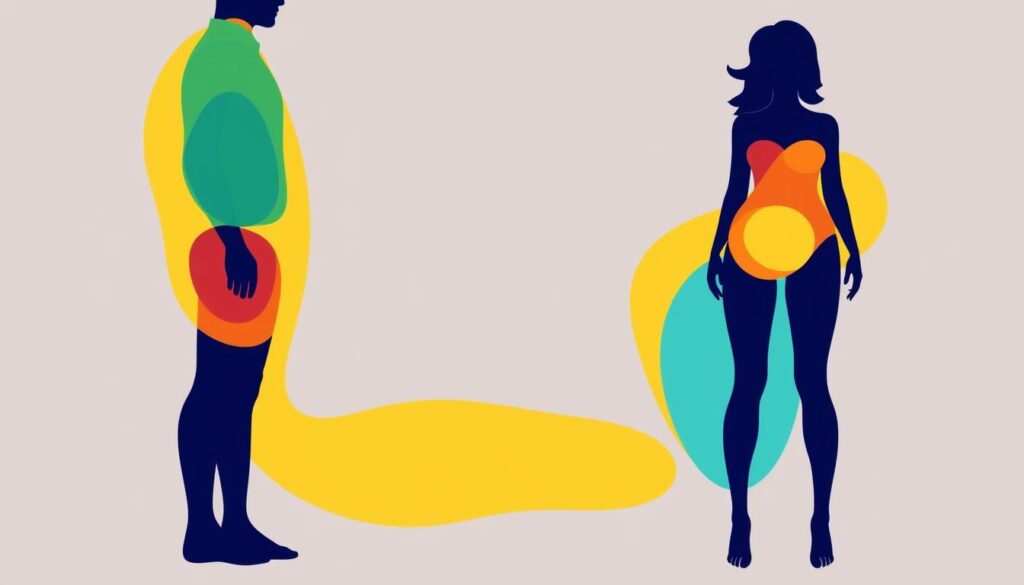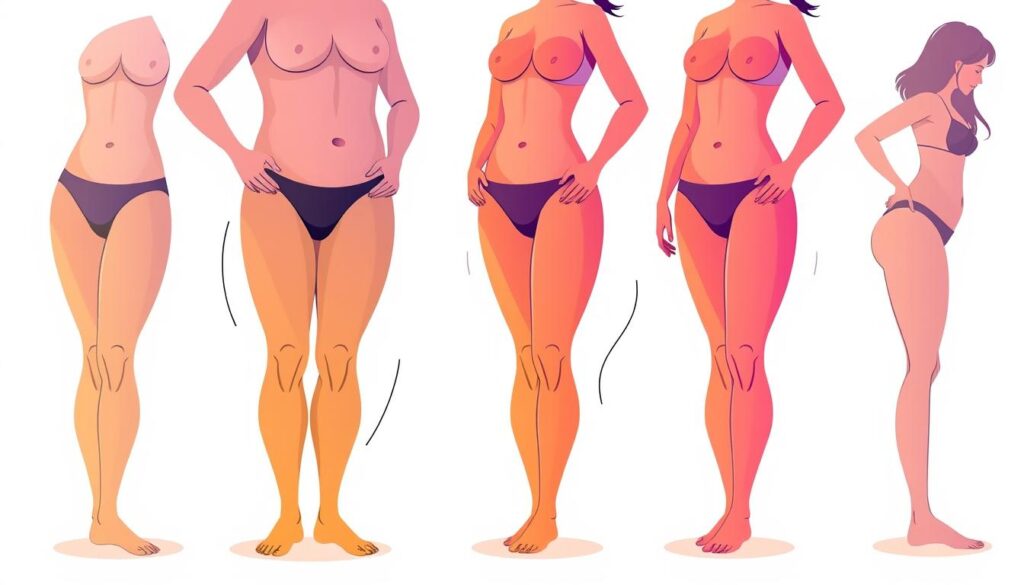Weight loss is different for everyone. It depends on your genes, age, gender, and hormones. Where you lose weight first can vary a lot.
Studies show that genes affect fat loss more in women than men. Your genes help decide where you store and lose fat. Sex, age, and hormones also play a part in these patterns.
Maybe you want to be healthier, perform better in sports, or feel more confident. Knowing where you lose weight first helps. It lets you set goals that fit you better. You can make a plan that works for your body and what you like.
Key Takeaways
- Weight loss patterns are highly individualized and influenced by genetic factors, especially in women.
- Sex, age, and hormones also play a significant role in where you tend to store and lose fat.
- Understanding your personal weight loss tendencies can help you set realistic goals and tailor your approach.
- Embracing your body’s unique fat distribution can lead to a more sustainable and effective weight loss journey.
- Factors like family history and metabolism changes over time can also impact your weight loss patterns.
By knowing where you lose fat and why, you can make a weight loss plan that fits you. Check out this link for more on how body fat distribution affects weight loss.
Understanding Body Fat Distribution Basics
When you want to lose weight, knowing about body fat is key. There are two main kinds: subcutaneous fat and visceral fat.
Types of Body Fat: Subcutaneous vs Visceral
Subcutaneous fat is right under your skin. You can pinch it and see it. Visceral fat wraps around your organs inside your belly.
The Science Behind Fat Storage
Fat storage in your body depends on many things. Your genes, hormones, and lifestyle play a big role. Where you store fat, like in your belly or hips, is based on these factors.
Common Fat Storage Areas
- Abdomen: This is a common area for both subcutaneous and visceral fat accumulation.
- Hips and thighs: These areas typically store more subcutaneous fat, often referred to as “pear-shaped” body type.
- Arms: The upper arms are a common site for subcutaneous fat storage.
Visceral fat is linked to health problems like heart disease and diabetes. Knowing the difference helps you focus on losing the right kind of fat.
“The key to successful weight loss is not just about the number on the scale, but rather understanding how your body stores and distributes fat.”
Where Is Weight Loss First Noticed in the Body
Many people wonder, “Where do I lose fat first?” The answer changes for everyone. It depends on your age, gender, genes, and body type.
At first, you might see fat loss in your face, neck, and upper body. Then, you might notice changes in your waist, hips, and thighs. But, how fat is lost can change with age.
For example, middle-aged men and postmenopausal women often lose weight first around their midsection. This is because older bodies tend to store more fat around the belly. This fat is hard to lose, but exercise and healthy eating can help.
| Gender | Initial Weight Loss Areas |
|---|---|
| Men | Waistline, chest, and abdomen |
| Women | Face, neck, upper body, and lower body (hips, thighs, and buttocks) |
Remember, losing weight is about eating right and exercising. These two things help you lose fat in the places you want. By doing these, you can see the fat loss you want.
How and where you lose weight first is unique to you. Be patient and keep working at it. Knowing how your body loses fat helps you reach your goals better.
The Role of Genetics in Fat Loss Patterns
When you want to lose weight, your genes matter a lot. They help decide where and how your body loses fat. New studies show how genes affect where fat goes and how it’s lost.
Hereditary Factors in Weight Distribution
Studies have found many genes linked to weight and obesity. Genes can affect your weight by 40-60%. More than 30 genes have been found to influence BMI, making it go up by 0.17 kg/m² on average.
Family History and Weight Loss Tendencies
Your family history can tell you a lot about your weight loss patterns. Twin and family studies show genes play a big role in BMI, from 40-60%. A study found a gene on chromosome 15 linked to weight loss after gastric bypass, but it’s not fully proven.
Genetics and weight loss are still being studied. Knowing your genetic predisposition can help you lose weight better. By using this knowledge with a healthy lifestyle, you can make your body burn fat more efficiently.
“Genetics play a significant role in determining where fat is distributed and lost in the body. Family history can indicate potential weight loss patterns, as obesity tendencies often emerge among siblings, parents, and extended family members.”
Gender Differences in Weight Loss Patterns
Men and women lose weight in different ways. This is because of fat types and hormones. Women usually have more fat under their skin, like in hips and thighs. This fat helps with pregnancy and breastfeeding.
Men lose fat faster, especially from their belly. This belly fat is deep and around organs. Losing this fat makes their waist smaller.
Women might find losing weight harder because of hormones and less muscle. Hormones change a lot, like during periods or menopause. Women also have less muscle than men, which affects how fast they lose weight.
| Characteristic | Men | Women |
|---|---|---|
| Fat Distribution | Tend to hold more visceral fat around the abdomen | Tend to hold more subcutaneous fat in the hips, thighs, and buttocks |
| Weight Loss Rate | Generally experience faster weight loss | May find weight loss more challenging due to hormonal factors |
| Muscle Mass | Generally have higher muscle mass | Generally have lower muscle mass |
| Metabolic Rate | Tend to have a higher metabolic rate | Tend to have a lower metabolic rate |
Knowing these differences helps in making better weight loss plans. It lets people and doctors create plans that work for everyone. This way, everyone can reach their weight loss goals in a good way.

Age-Related Factors in Fat Distribution
As we get older, our bodies change a lot. This includes how fat is spread out. Many people worry about gaining weight and how their metabolism changes with age.
Hormonal Changes and Weight Loss
Hormones play a big role in how we manage our weight as we age. Women going through menopause might find it hard to lose weight. This is because of changes in estrogen and other hormones.
These changes can make it tough to lose belly fat. It’s harder to lose weight, especially around the middle.
Metabolic Changes Over Time
Our metabolism changes as we age. It usually peaks in our early 20s and then starts to slow down. This slowdown makes it harder to keep a healthy weight.
Many people gain weight as they get older. This is because their metabolism slows down.
| Statistic | Findings |
|---|---|
| Muscle mass decline with age | Even in older persons with stable weight, muscle is replaced by fat over time. |
| Weight gain from early adulthood to midlife | Relates to increases in both fat and muscle mass, but weight loss at older ages is associated with a disproportionate decline in muscle mass. |
| Waist circumference and visceral fat increase | At a greater rate than total weight, reflecting changes in fat distribution. |
| Visceral fat increase | Over 200% in men and 400% in women between the 3rd and 7th decades of life. |
Changes in hormones and metabolism affect our weight and body shape as we age. Knowing this can help us make better choices for our health. It’s about dealing with age-related weight gain and metabolism changes in our own way.
The Truth About Targeted Weight Loss
Many think they can lose fat in certain spots first. But, the spot reduction myth is not true. Losing weight really means losing fat all over through diet and exercise, not just in one spot.
Research shows that working out a certain area doesn’t just make that area thinner. For example, a study with female soldiers found they lost fat from their arms and trunks. But their leg fat didn’t change much. This shows that where fat goes is mostly based on genetics and hormones, not just exercise.
| Myth | Reality |
|---|---|
| Spot reduction: Targeted exercises can reduce fat in specific areas | Scientific evidence suggests that targeted fat loss is not possible. Overall body fat reduction through a combination of diet and exercise is the key to effective weight loss. |
Instead of trying to lose fat in one spot, focus on a healthy lifestyle. Eat well and exercise a lot. This way, you can lose fat all over and look better over time.
“Targeted exercises do not lead to localized fat loss. Effective weight loss requires a combination of diet and exercise to reduce overall body fat.”
Getting healthier is a big job, not a quick fix. It’s better to make lasting changes than to believe in myths. Knowing how fat works helps you make a good plan to reach your goals.
Common First Areas of Fat Loss for Women
Women often lose weight in different ways than men. The places where they lose fat first can change a lot. Knowing these patterns helps women set better goals and work towards their goals.
Upper Body Changes
Women usually lose fat in the upper body first. This includes the face, neck, and arms. They have more fat in these areas. So, when they start losing fat, these areas look slimmer and more defined.
Lower Body Fat Loss Patterns
The lower body, like the hips and thighs, takes longer to lose fat. This is because these areas help with pregnancy. So, the body holds onto fat here longer.
But, with a good diet and exercise, women can lose fat in these areas too. They will see their body shape change over time.
“Consistency is key to successful weight loss; sticking to calorie and exercise goals will produce noticeable results over time.”
Exercise Impact on Fat Loss Distribution
Many think that exercise for fat loss can target certain body parts. But, it’s not that simple. Exercise is key for health and weight control. Yet, where fat is lost depends on more than just working out.
Running and HIIT (High-Intensity Interval Training) are great for losing visceral fat. This fat is bad because it’s near organs. It raises the risk of diseases like diabetes and heart issues.
For the best results, mix workout effectiveness with both cardio and strength training. This combo boosts calorie burn and builds lean muscle. It’s a winning strategy for losing fat and improving body shape.
Targeted fat loss is a myth. Exercises might seem to focus on certain spots, but fat loss is mostly based on genetics and hormones. Aim for a healthy calorie deficit with diet and exercise. This way, your body loses fat slowly and safely.

Knowing how exercise affects fat loss helps you set better fitness goals. Stick to it, be patient, and understand your body’s needs. These are the secrets to lasting success.
Belly Fat: Understanding Visceral Fat Loss
Most body fat is under the skin. But visceral fat around organs is a big health risk. It can lead to diabetes, heart disease, and some cancers. You can fight this fat.
To lose belly fat, you need a plan. Eating foods with low glycemic index and lots of veggies helps. Also, eat more protein and cut down on sugars and alcohol. Exercise, especially hard workouts, is key.
Seeing less visceral fat takes time, but it’s worth it. It lowers your risk of serious diseases. Keep working towards a healthier you. It’s a journey, but you can do it.

